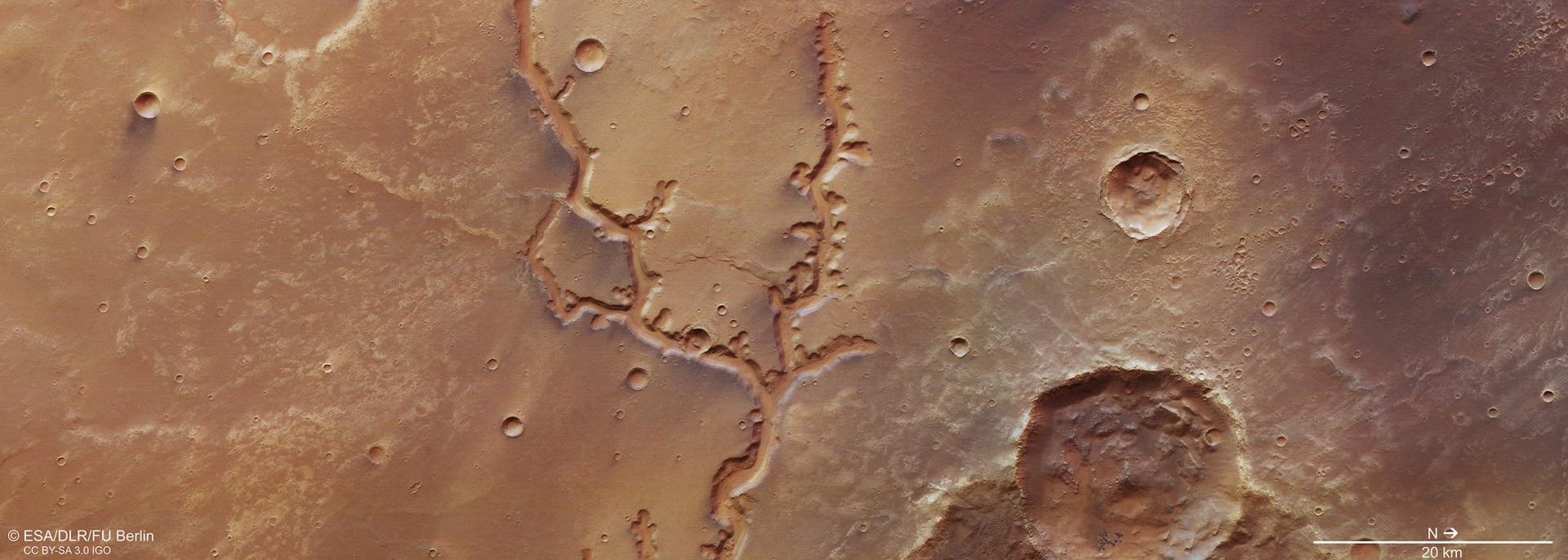Featured image: The Nirgal Vallis river valley on Mars as seen by the HRSC Camera onboard the European Space Agency’s Mars Express mission. Image credit: ESA/DLR/FU Berlin.
Paper: Valley formation on early Mars by subglacial and fluvial erosion.
Authors: Anna Grau Galofre, A. Mark Jellinek & Gordon R. Osinski.
“Some say the world will end in fire/ Some say in ice” begins the famous poem by Robert Frost. But what about how worlds begin? For years the theory of a “warm and wet” early Mars has been the conventional explanation for the vast valley networks formed billions of years ago that we can see on the surface today. Now, a new study suggests that at least some of these valleys could have formed under colossal ice sheets, in a distinctly more icy world.
Mars is a cold and dry world today, but ancient networks of valleys give us reason to think that the planet once had rain and rivers flowing across its surface. This suggestion comes from comparing what we see on Mars to similar landforms on Earth. Many of the valleys we see on Mars look similar to rivers valleys that we know were formed by rain on Earth. The problem with this theory for Mars however, is that it doesn’t match up with climate models that predict a colder, icy ancient Mars. A new study led by Anna Grau Galofre and co-authors makes an alternative case: that large ice sheets covered the southern highlands of Mars at the time of valley network formation, and that many of the valleys we see today formed beneath this ice.
How did the team come to this different conclusion? The authors were influenced by locations such as Devon Island in the Canadian Arctic. They know that in this location, rivers have been formed underneath ice, and not just by water running across the surface. This raises the question of whether similar processes could have formed valleys on early Mars. To explore this idea, the authors used images obtained from satellites around Mars to create a classification algorithm using principal component analysis (PCA), a method commonly used to explore and explain variance in a dataset by taking a lot of information and reducing it down to the fundamental components that describe most of the data. They also compared the shapes and features of valleys on Mars to valleys found underneath ice on Earth.
Their algorithm classified martian valleys into categories according to whether they were most likely to have been formed by processes involving running water on the surface, the movement of ice, the flow of water underneath ice, or the seeping of water out of the ground. The scientists had previously developed physical models of how the processes of erosion form valleys. Each process tends to leave subtly different looking landforms, which each have different implications for the early climate of Mars. Therefore, the team could use measured quantities such as the angle between the main channel and tributary channels, the ratio of a channel’s length to its width, and the degree of branching of the channels in a network, in order to work backwards to determine the most likely process of formation.
Altogether the team analysed 10,276 individual Martian valleys from 66 valley networks by comparing them with 40,000 simulated valleys in their algorithm. They found that only 14 of the valley networks were best explained by water runoff across the surface and that 22 of the valley networks were best explained by water melting beneath ice. Of the remaining valley networks, 3 were best explained by water seeping out from the ground and 18 were not distinct enough to assign a formation mechanism. This approach of analysing valley networks at a global scale and performing a statistical analysis is a new and exciting approach, and the results challenge the conventional view of a warm and wet ancient Mars. The early climate of Mars has important implications for what life might have existed, and how we might best look for evidence of that past life today.
The study doesn’t conclude that there was no rain, snow or running water on the surface of ancient Mars, but it does suggest we should rethink our previous assumptions about what early Mars was like. So although Robert Frost may “hold with those that favour fire” for the world’s end, for the beginnings of the landscape of Mars, perhaps we should favour ice!
How did valleys form on early Mars? Some say in ice… by Eleni Ravanis is licensed under a Creative Commons Attribution-ShareAlike 4.0 International License.

